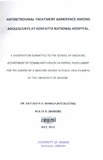| dc.description.abstract | Young people including adolescents constitute a significant number of the people living with Human Immune Deficiency Virusl Acquired Immune Deficiency Syndrome (HIV/AIDS) in the world today. It is estimated that as many as 50% of new infections worldwide occur among those between the ages of 15-24 years (UNAIDS 2008). In addition, the introduction and effectiveness of pediatric antiretroviral treatment (ARVs) has resulted in decreased mortality in perinatally infected children thus they are living to adolescence and adulthood. Adherence to treatment is of critical importance as poor adherence is related to development of viral resistance! resulting in reduced treatment options and increased HIV/AIDS morbidity and mortality. Adolescents face unique challenges in taking their medications and no studies have been done in Kenya to characterize the adherence pattern and explore factors that influence adherence in this group.
Objectives
The main objective of the study was to assess the level of adherence among adolescents at Kenyatta National hospital. (KNH) on Highly Active Antiretroviral therapy (HAART) and to identify' the factors associated with adherence.
Methodology
This was a cross-sectional study at KNH between March and June 2D09. The study included adolescents aged 10-19 years who were on ARVs for at least six months prior to the study. Focus group discussions (FGDs) were used to collect qualitative data and quantitative data were collected using a structured questionnaire. Good adherence was defined as taking 95% or more of all prescribed medications. Appointment keeping was assessed for the six months prior to the visit and drug refill records abstracted from pharmacy database.
Results
The study surveyed 158 adolescents and held three FGDs. Majority, 143 (90.5%) were on first line treatment (two NRTIs and one NNRTI). The mean duration of treatment was 33 months (IQR 22-47). Overall, 148 (93.7%) Of the adolescents had good self-reported it adherence of more than 95%. Of the adolescents surveyed, 153 (96.8%) kept their scheduled clinic appointment and 151 (95.6%) refilled their drugs on time. Of the 24 adolescents who reported missing doses, forgetting to take medication 10 (41.7%), being away from home 6 (25%) and school schedule 4 (16.7%) were identified as the commonest reasons for not taking medication. In both the quantitative and qualititave methods, stigma and lack of social support were identified as significant barriers to adherence in adolescents. Extensive adherence counseling before treatment initiation as well as during treatment, peer counseling and support groups were important promoters of adherence.
Conclusion
Overall there was: good adherence in adolescents in KNH hospital with 93.7% of all the adolescents reporting 2:95% adherence. This illustrates that it is possible for adolescents in our setting to achieve and maintain optimal adherence levels. Common reasons for non adherence such as forgetting and conflicting schedule can be addressed by reminder devices and tailoring treatment to fit the adolescents' lifestyle. Adherence will be enhanced by addressing stigma, adherence counseling, peer counseling and support groups. | en_US |

